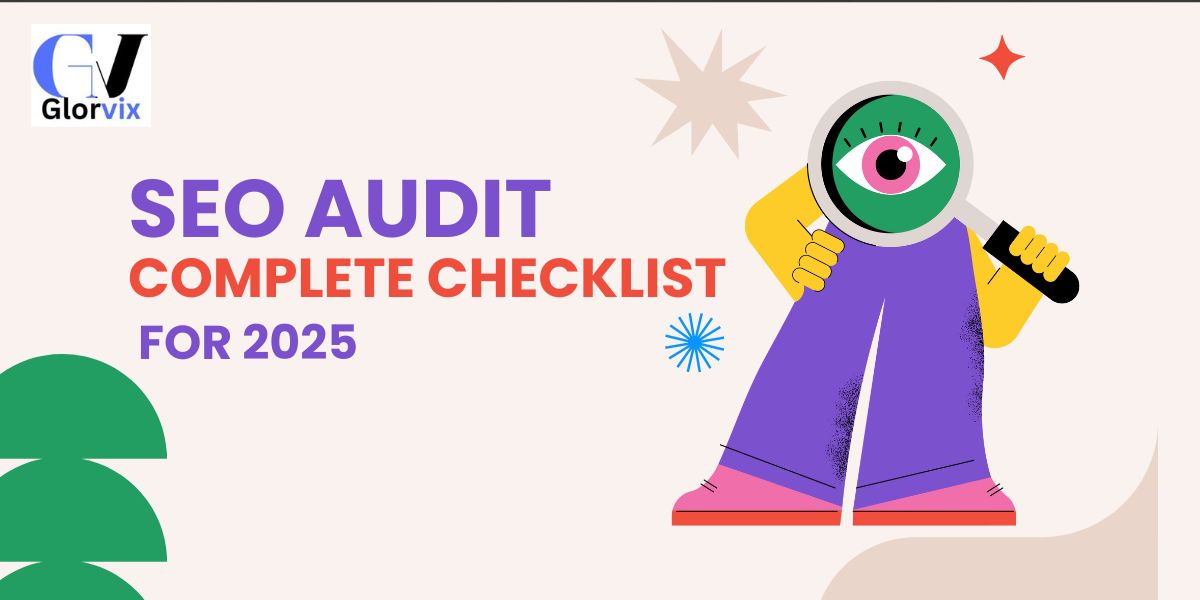SEO Auditing checklist 2025 by Glorvix com
Introduction to SEO Auditing for 2025
SEO auditing has become essential for maintaining competitive rankings, especially with rapid changes in search algorithms. This SEO Auditing Checklist 2025 by Glorvix com covers all aspects of technical SEO to ensure your site is optimized and meets the latest standards.
Technical SEO Checklist

Technical SEO is foundational to improving search engine visibility. By following these steps, you can ensure your site is optimized for both users and search engines.
1. Audit Your Website
A comprehensive audit reveals areas for improvement, providing a starting point for your technical SEO efforts.
- Crawl and Indexing Check: Use tools like Google Search Console or Screaming Frog to identify pages that may not be indexed.
- Broken Links: Regularly audit for broken links, which can harm SEO and user experience.
- Canonicalization: Check for canonical tags to avoid duplicate content issues.
2. Speed Up Your Site
Page speed is a crucial ranking factor that impacts user engagement. A fast-loading site enhances the user experience and SEO performance.
- Image Compression: Use tools to compress and optimize images for faster load times.
- Minify CSS and JavaScript: Reducing file sizes for CSS and JavaScript can improve load times.
- Enable Browser Caching: Browser caching saves resources, making pages load faster for returning users.
3. Improve Crawling
Ensure search engines can effectively crawl and index your content, as this affects visibility and ranking.
- Sitemap Optimization: Update and submit your XML sitemap to ensure all critical pages are indexed.
- Robots.txt Configuration: Use the robots.txt file to guide search engines on which pages to crawl.
- Eliminate Crawl Errors: Monitor and fix crawl errors reported in Google Search Console.
4. Make Your Site Mobile-Friendly
With Google’s mobile-first indexing, it’s essential that your site works seamlessly across mobile devices.
- Responsive Design: Ensure your design adapts smoothly to different screen sizes.
- Touch-Friendly Navigation: Optimize for mobile usability with larger buttons and simple navigation.
- Mobile Page Speed: Prioritize mobile load speeds to improve both user experience and SEO With Glorvix.com
5. Boost Core Web Vitals
Core Web Vitals are specific user experience metrics that Google prioritizes, including LCP, INP, and CLS.
- Largest Contentful Paint (LCP): This measures the time it takes for the main content to load. Aim for under 2.5 seconds.
- Interaction to Next Paint (INP): A new metric for 2025, this tracks the responsiveness of your site to user interactions.
- Cumulative Layout Shift (CLS): This tracks unexpected layout shifts; keeping this low ensures a stable visual experience.
6. Enhance Website Security
Security is not only vital for user trust but also for SEO, as Google favors secure sites.
- SSL Certificate: Ensure your site uses HTTPS for a secure connection.
- Regular Security Audits: Use security tools to detect and fix vulnerabilities.
- Update Plugins and Software: Regularly update all plugins, themes, and software to protect against threats.
7. Improve Website Navigation
A well-structured navigation setup improves the user experience, helping visitors find information quickly.
- Intuitive Menu Structure: Simplify menus to help users find content with minimal clicks.
- Breadcrumbs: Breadcrumbs provide a navigational trail and help with SEO by reinforcing site structure.
- Clear Hierarchy: Organize content under logical categories for better indexing and user flow.
8. Internal Links
Internal linking is essential for SEO as it distributes authority across pages and aids in site navigation.
- Strategic Link Placement: Add internal links to important pages to improve page authority.
- Anchor Text: Use descriptive anchor text that reflects the topic of the linked page.
- Limit Excessive Links: Avoid overloading pages with links to maintain focus and improve link authority.
9. Status Codes of Internal Links and Review of Outbound Links
Regularly reviewing internal and outbound links helps maintain link quality and site authority.
- Check Status Codes: Use tools to ensure internal links return a 200 status code (success) rather than 404 errors.
- Outbound Link Quality: Link to reputable sites and review outbound links to ensure they’re still relevant.
- Redirect Issues: Avoid redirect chains that can slow down your site and impact link value.
10. Monitor Algorithm Updates

Google frequently updates its algorithms, impacting rankings and visibility. Stay updated to keep your SEO strategy aligned.
- Follow Industry News: Use resources like Search Engine Journal and Moz to stay informed on updates.
- Adjust Content and SEO Strategy: Adapt your content and technical SEO approach based on algorithm changes.
- Observe Performance Metrics: Keep an eye on performance metrics to assess the impact of any algorithm updates.
11. Keep Track of ROI
Tracking SEO ROI ensures your efforts translate into measurable results.
- Set Measurable Goals: Define clear objectives, such as increased organic traffic or higher conversions.
- Use Analytics Tools: Google Analytics and Search Console help measure organic traffic, bounce rates, and user engagement.
- Regular Reporting: Create periodic reports to monitor progress and make data-driven adjustments.
Technical SEO vs Content SEO
Understanding the distinction between technical SEO and content SEO helps create a balanced SEO strategy.
- Technical SEO: Focuses on optimizing the site’s backend, such as crawlability, speed, and security. Glorvix SEO
- Content SEO: Emphasizes high-quality, relevant content that meets user intent.
- Balancing Both: Both technical and content SEO are crucial; technical SEO ensures accessibility, while content SEO attracts and engages visitors.
Write Your Checklist
Creating your own SEO checklist based on this SEO Auditing Checklist 2025 by Glorvix com can streamline your SEO auditing process.
- Start with a Site Audit: Identify and address any underlying issues.
- Optimize Speed and Core Web Vitals: Ensure fast loading and a smooth user experience.
- Secure Your Site: Make sure HTTPS and other security measures are in place.
- Review Link Quality: Check for broken or irrelevant links.
- Track and Adjust: Monitor your site’s performance and make adjustments based on analytics.
Conclusion: Staying Ahead with SEO Auditing Checklist 2025 by Glorvix com
Following the SEO Auditing Checklist 2025 by Glorvix com provides a structured approach to achieving and maintaining SEO excellence in 2025. From technical foundations to content quality and ongoing monitoring, these steps help ensure your site is fully optimized for search engines and users alike. By committing to regular SEO audits, you can navigate algorithm changes, improve user satisfaction, and maximize your site’s potential.







